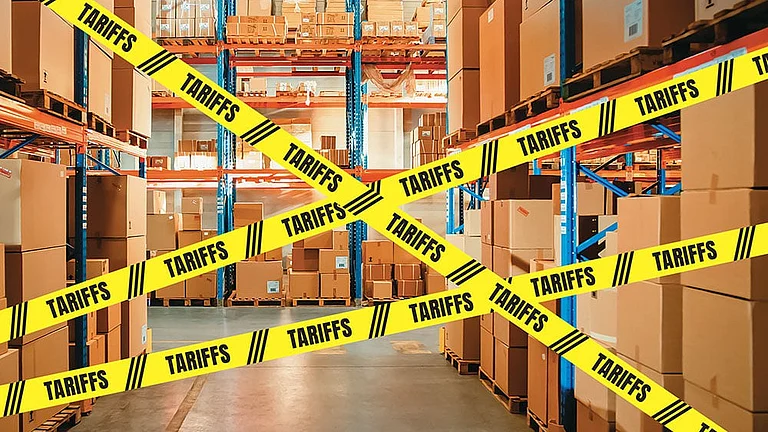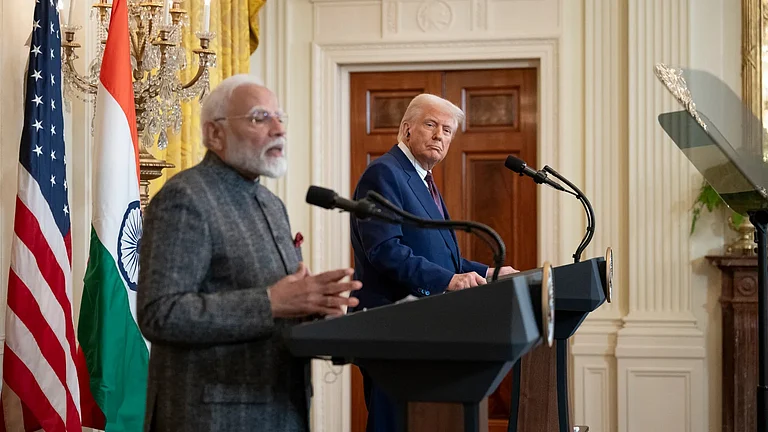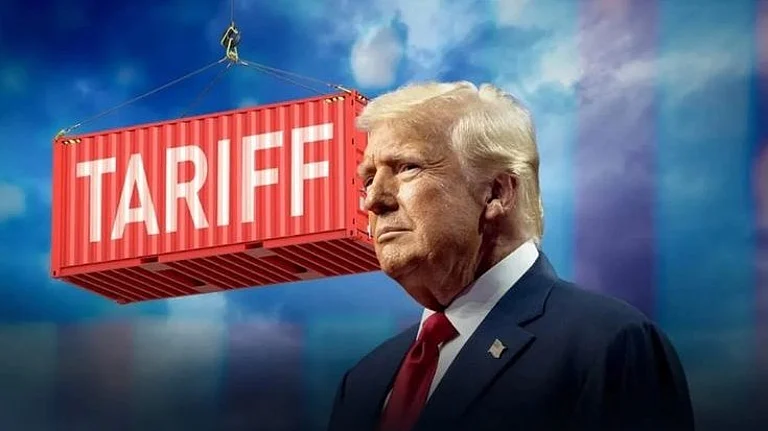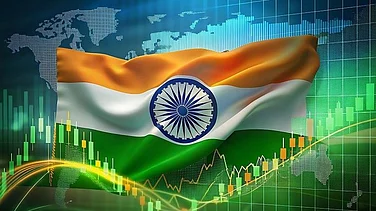As the MAGA (Make America Great Again) caravan rolls triumphantly into Washington to celebrate the return of its poster boy, Donald Trump, after four years of acrimonious exile, the world holds its collective breath in a state of trepidation. The reason? The fear of Don’s iconoclastic style of leadership that has already seen the financial capitals of the world fortify their “iron domes.”
The mere apprehension of the trade salvoes that a MAGA-driven Trump may fire, targeting chiefly economic behemoths like China, the EU and India, has seen currency values and stock markets tumble globally. The rupee, for example, has crashed 2% against the US dollar since November 5, the day of the US Presidential election results, compared to a 4.71% decline over the entire year. This has inflated the country’s import bill, presenting new economic challenges that experts believe may not abate if Trump rules by his playbook.
Declining Export Despite Falling Rupee
While India might not be the principal focus of the Don’s trade offensive, the nation has reasons to worry given its widening trade deficit—to $21.94 billion in December 2024, up from $18.76 billion a year earlier, driven by a 0.99% year-on-year contraction in merchandise exports.
In a contrarian trend, India’s exports have continued to slide despite the depreciation of its currency, with the service sector being the only exception. Owing to the robust performance of this sector (essentially IT and related services), the country’s exports registered a growth of 1% over the December 2023-24 period, masking the underwhelming performance of industrial verticals, including merchandise exports, which slumped by 1%, underscoring the impact of structural challenges in trade and raising concerns over India’s export-driven growth aspirations.
A weakening currency often impacts critical import-heavy sectors, from crude oil and electronics to gold, driving up costs for an economy already struggling with persistent inflationary pressures. While conventional economic theories suggest a depreciating currency should bolster exports by making them more competitive globally, India’s trade patterns paint a different picture. Experts note that sectors with high import content—such as energy and electronics—have shown resilience, but labour-intensive, low-import industries like textiles are struggling to capitalise on the weaker currency. This disparity underscores the structural inefficiencies in India’s export ecosystem, particularly in value-added manufacturing.
“Currency fluctuations inevitably impact goods exports everywhere. However, in our case, goods are a small part of the overall exports basket, which is dominated by the services sector,” said Dr Arpita Mukherjee, professor and senior researcher at Indian Council for Research on International Economic Relations (ICRIER).
With turbulence in the air, exporters in India may hit the pause mode, setting a stop loss at 86.25, as the rupee continues to fade amid an increased demand for the dollar, driven partly by Trump’s America-first trade policies. To promote trade in rupees, the RBI is urging Indian banks to open rupee accounts overseas and facilitate cross-border transactions in INR and local currencies. Additionally, Indian exporters can maintain foreign currency accounts abroad to settle export proceeds and utilise these funds for import payments.
“Foreign buyers monitor currency movements 24/7. So, when they find the rupee depreciating, they ask Indian exporters to cut prices proportionally and, therefore, a falling currency doesn't necessarily help unless the contract is already done and booked,” said Anil Bhansali, head of treasury at Finrex Treasury Advisors.
During the 2014 to 2024 period, overall merchandise exports grew by 39%, but high-import sectors like electronics, machinery, and computers saw much higher growth. Low-import sectors such as textiles and clothing experienced negative growth, even though a weak rupee should have made their goods more competitive globally. These trends suggest that a weaker rupee doesn’t always boost exports, particularly when it is accompanied by rising input costs and persistent inflation.”
“Higher import costs for items like crude oil, coal, vegetable oil, gold, electronics, and chemicals drive up energy bills and inflation, erasing the advantages of currency depreciation. India’s high raw material, industrial power, capital and logistics costs worsen the situation,” said Ajay Srivastava, founder of GTRI.
Furthermore, the nation’s growing need for imports, particularly from China, exacerbates these challenges. Despite the government's "Make in India" initiative, aimed at boosting domestic manufacturing and reducing reliance on imports, the country’s dependence on Chinese raw materials has paradoxically increased.
Focus on Manufacturing
To achieve its ambition of becoming a global manufacturing powerhouse, India must curb its import dependency, ensure competitive production costs and safeguard domestic industries from potential dumping of Chinese raw materials.
“China has been dumping its raw materials on India due to the overvaluation of the rupee by around 8%. However, with the Chinese yuan depreciating only slightly compared to the rupee, the volume of these dumped goods is expected to taper. While these factors will impact imports, it will likely take two to three months before a noticeable decline in imports is observed,” added Bhansali.
India’s inability to boost manufacturing increases the odds. According to experts, declining manufacturing output in the decades following the economic liberalisation of 1991 has turned India into a perennial net importer of goods and services, burdened with significant trade deficits. The resultant structural imbalance accentuates the impact of a weakening rupee: It amplifies the cost of imports and strains external accounts.
“The nature of imports is a real challenge. Oil is, by far, India's biggest import, almost 20% of the total. Since oil demand doesn't fall when prices rise, a weakening rupee exacerbates the trade deficit and, more importantly, fuels inflation,” added Dhiraj Nayyar, chief economist, Vedanta Resources Limited. A Free Trade Agreement with the EU, under negotiation for the last two decades, could be a panacea as it may translate into a higher share of the export market for India at the cost of China and its competitors.
Striking The Mid-way
According to experts, if India needs to boost its trade and minimise import dependence amid currency volatility, the government must dial down import duties. With Trump’s return to power, uncertainties are expected to rise, potentially worsening India’s trade deficit, which stands at nearly $200 billion. While gold and electronics imports may be partially addressed by domestic production, India must focus on boosting exports and minimising import duties to narrow the deficit gap.
“On top of unconscionably high import duties, currency depreciation is an added concern. Equally, India’s competitiveness in services and the rising import bills cannot be ignored, and we must explore cost-effective alternatives," Mukherjee observed. Further, the competition between imported intermediates, raw materials, and domestic manufacturing could drive protectionist measures, potentially boosting domestic sourcing, he observed.
Additionally, India must step up its efforts to develop a competitive manufacturing sector with moderate tariff protections and targeted subsidies like PLIs. Nayyar noted that a weaker rupee complements such a strategy by boosting the competitiveness of Indian exports globally and promoting import substitution in key sectors.
Amid the fanfare of Trump’s return to power, India cannot lose sight of its priorities, with its currency expected to fall further amid trade uncertainties and rising economic turbulence. Experts are unanimous that the country must do all it can to reduce imports, narrow trade deficits, invest in manufacturing competitiveness and foster innovation. It is clear that policy recalibration by way of softer import duties, expansion of PLI-like schemes and conclusion of long-pending FTAs could contribute significantly to helping India build its economic iron dome. And beyond that, launch offensives of its own.































